Living History Museums struggle to draw visitors
---------------------
Reprinted from 12/2005 -- in response to some comments on a recent blog entry
---------------------
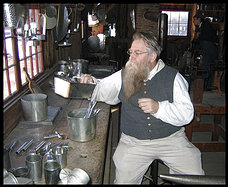
Photo: David A. Fahrenthold/Washington Post. Chip Leis, 57, works in the tinsmith's shop at Old Sturbridge Village in Sturbridge, Mass.--one of many "living history" museums now struggling to hold their audience in the age of video games and overcommitted kids. Leis, a 15-year veteran of the 1830s-replica village, said he's noticed a change in the kids that come into his shop. "I see more pushing," he said.
Last week, the Washington Post ran this story, "Living-History Museums Struggle to Draw Visitors: Creativity Drives Changes in Hunt for Attendance," about the difficulties that living history museums such as Colonial Williamsburg are having in drawing attendance and competing with the variety of new experiences in culture, history, arts, and other attractions, and that they are responding by changing, sometimes in ways that aren't historically accurate.
From the article:
Historical fact: In the 1830s, many rural New Englanders followed a religion so strait-laced that they did not celebrate Christmas. Accordingly, at Old Sturbridge Village -- an outdoor museum where an 1830s town has been re-created down to the cider mill and the Gloucester Old Spots pigs -- they used to ignore the holiday as well. Used to. Until, in the past few years, attendance started to slip...
Now, in December the village gets a makeover that might make a Puritan -- or a historian -- blanch. There is a Christmas tree (not popularized in the United States until the 1840s), a visit from Santa Claus (who didn't take his current form until after 1850) and a series of nighttime tours showing the village lit by (electric) candlelight. These are times for creative thinking at the country's "living history" parks, where officials worry that their old formula of restored buildings, costumed interpreters and anvil-banging demonstrations is losing its tourist appeal.
Museums from Virginia to Michigan are trying to add an edge. How about a walk-through theatrical production? An overnight stay in a pilgrim's house? Who'd like to try on 19th-century replica underwear? In this fast-moving age, apparently, just making the past come alive isn't enough.
"It's just a larger, competitive world," said John Caramia, a North Carolina museum official and past president of the Association for Living History, Farm and Agricultural Museums.
Interestingly, last week, independently, the Wall Street Journal ran an piece on the same subject, "Why Rural Museums Are Becoming Ancient History," by Bruce Courson, director of the Sandwich Glass Museum in Sandwich, Massachusetts. He links this to changes in travel patterns, from the automobile to increasingly inexpensive plane travel, which broadened the options of vacation travel from local environs to almost anywhere in the world. From the article:
It was disheartening to learn last month in the Boston Globe of Old Sturbridge Village's recent layoffs and closure of several major facilities. The museum is a living history museum in central Massachusetts that depicts 1830s New England life on a 200-acre site with 40 period buildings. One thousand reservations for Thanksgiving dinner, a tradition since the 1950s, had to be canceled this year. A new tavern and motel, which were expected to generate much needed revenue for the Village when they opened in 2001, will be shuttered in January. Only 20 of the once nearly 70 costumed guides remain.
It is a story increasingly common for rural Massachusetts museums within a day's drive of major metropolitan areas. Many have current paid attendance numbers that are nearing 50% of what they were three decades ago. My own institution, the Sandwich Glass Museum, saw attendance drop from 84,000 in the early 1980s to 42,000 in 2000. Published figures and statistics I have gathered over several decades point to similar trends in nearby maritime and historical museums, not only in Massachusetts but along the Boston-Washington corridor as well. Considering all that we hear about "the museum boom" in major cities occurring during that same period, this might seem a surprising state of affairs.
Numerous causes have been cited for this precipitous decline, including the weather and 9/11. But one factor stands out among the reasons behind this consistent, decades-long trend: the 1978 deregulation of the airline industry and a new era of cheap air travel. Before deregulation, most vacations were taken in the summer and the automobile was the affordable, preferred means of travel. After 1978, however, inexpensive travel and free "frequent flier" tickets gradually became available. As a result, passenger counts more than doubled between 1978 and 1998. The vacationing public increasingly opted to leave their cars at the airport and, at any time of the year, fly to their destinations. Since 1978, the likes of Glacier Bay, Alaska, the Galapagos, or a Caribbean cruise have become affordable and popular attractions. Changing leisure-travel patterns among the American public are not a new phenomenon: A historic parallel occurred when Coney Island's Steeplechase Park succumbed to the post-World War II "automobile vacation" in 1964.
Today's Crankshaft comic makes an apt point about competition and the need to respond. These are difficult questions. Do you "sex up" history in order to compete? The International Spy Museum in DC has been very successful, drawing between 700,000 and 1 million paid admissions annually, in a city where most of the museums are free. During the same period, the City Museum of Washington failed.
I mentioned before that last year I participated in a Great Tours workshop produced by the historic sites division of the National Trust. That exercise, which is the equivalent of a charrette, but for local history sites, is one that most such institutions could benefit from. I have said for quite some time that we need to do a "city-wide" local history charrette based on this model, in order to learn from the failure of the City Museum and to focus on the somewhat unique market development issues of the "local history story" in Washington which has to compete with the "National/Federal history" story that defines Washington DC to most people across the country and throughout the globe.
Note that the Nashville City Paper reports that "Cracker Barrel retail sales drop." I wonder what that means. Probably has to do with the price of gasoline. Cracker Barrell is a folksy southern-based restaurant chain that sells a lot of junk in retail sections that are adjacent to the cashier's area. My sense is that if people are doing more local-oriented trips, because of the cost of gasoline, they are likely to cut back on discretionary purchases such as these. Restaurant sales were up slightly in the same period as the 10% decline in retail sales.

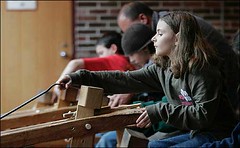
Amy Chambers, of Southington, Conn., worked on wood in the Education Center at the village. To keep young people interested, the village's management is working to institute more interactive exhibits and events, including online activities.(Globe Staff Photo / Bill Greene).
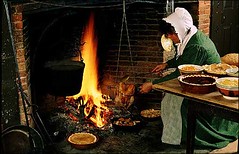
The village has also called off this week's Thanksgiving dinner, a holiday tradition at the museum since the 1950s. About 1,000 guests, including tourists from all over the country, had planned to attend the annual feast.(Globe Photo / Thomas Neill)
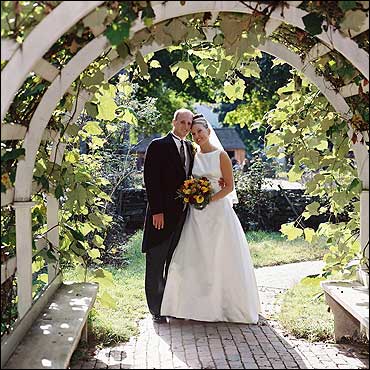
The tavern opened in 2001 and hosted about 50 wedding receptions each year. The restaurant will remain open until January 1 and will handle weddings scheduled through the end of this year, according to Beverly Sheppard, the village president. (Globe Photo / Thomas Neill)
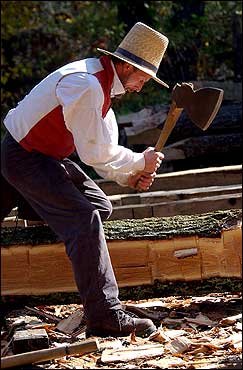
John Canavan used an ax to work on building a new home. The village has reduced peak-season staff from about 375 to about 340. (Globe Staff Photo / David L Ryan)
Labels: cultural heritage/tourism



0 Comments:
Post a Comment
<< Home